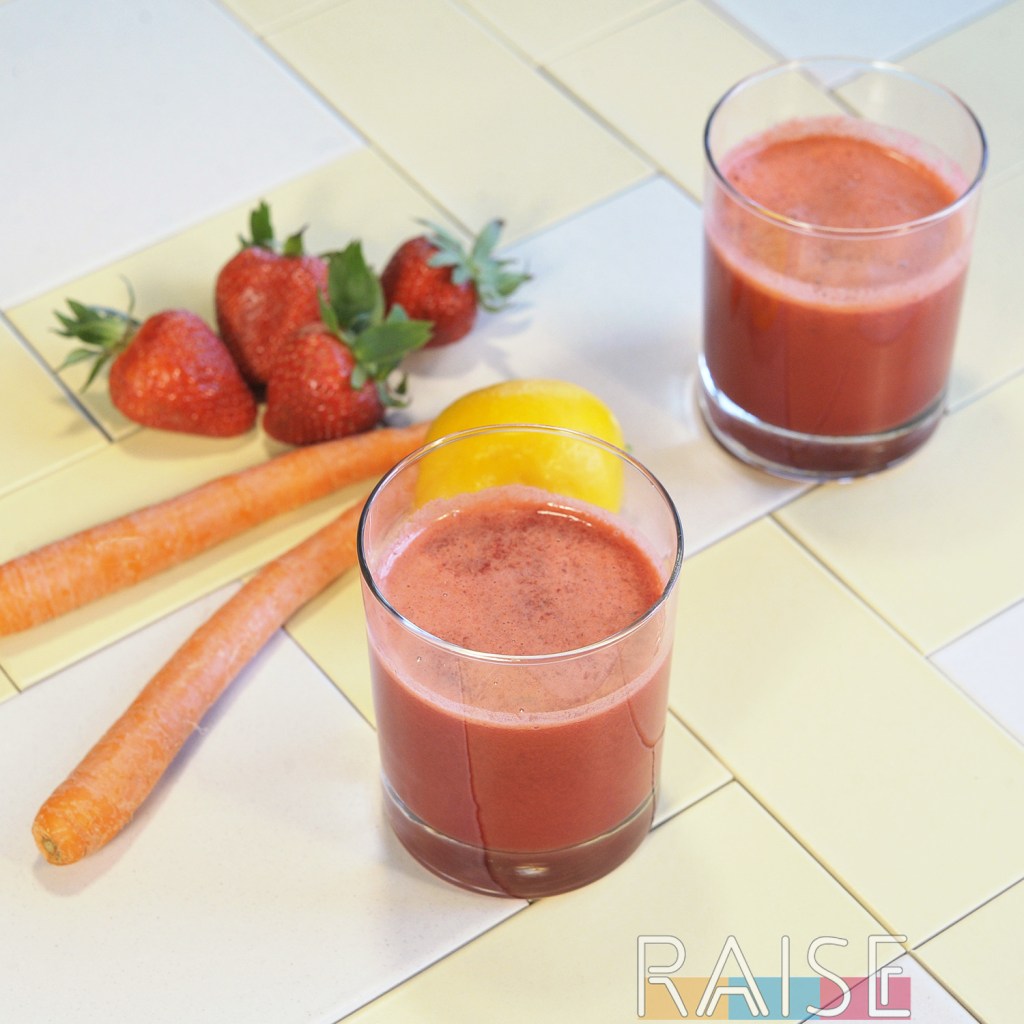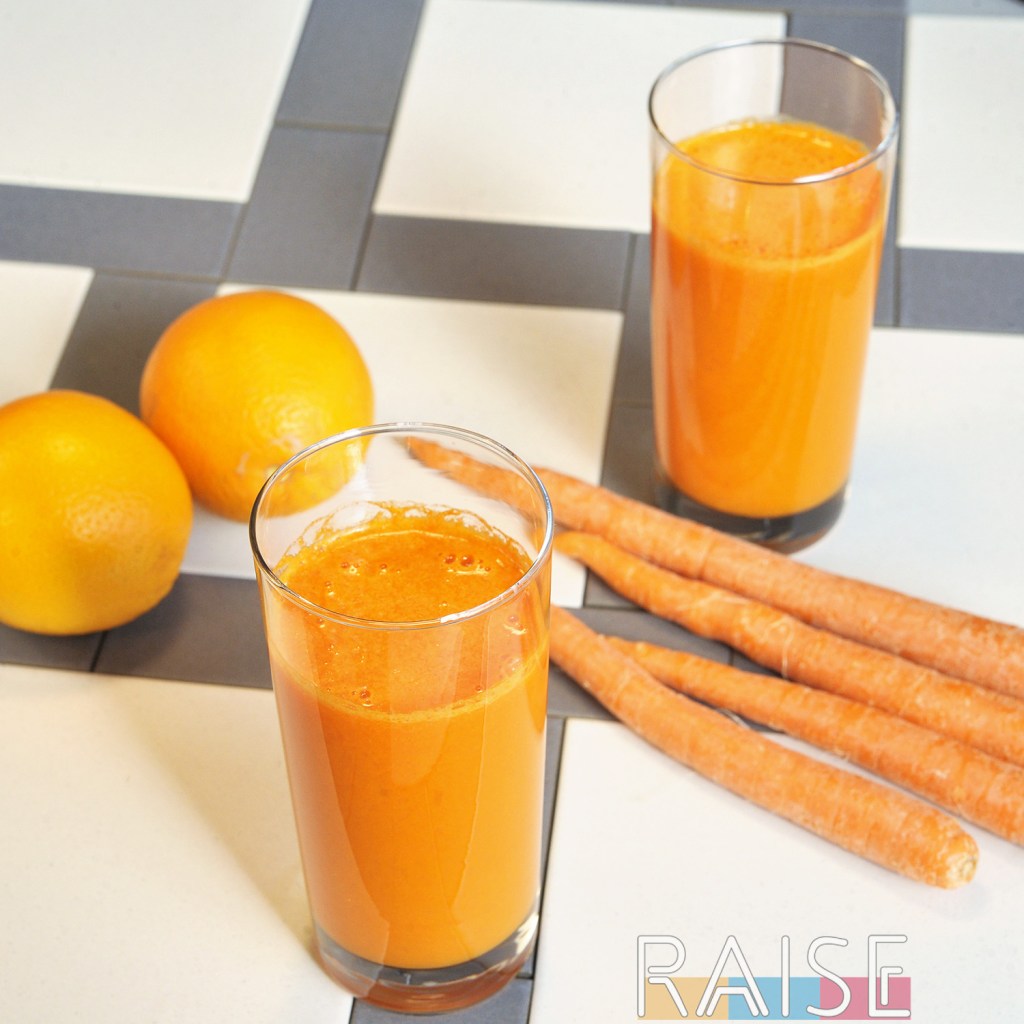Do you peel carrots before juicing? No, you don’t have to peel carrots before juicing them. You can absolutely run unpeeled carrots through your juicer. In fact, this is true of most root vegetables. Just be sure to wash your carrots before juicing them, even if they’re organic carrots.
Now, let’s take a look at juicers, the juicing process for carrots, and some very fun things you can do with your extracted juice.
Types of Juicers
There are two main types of juicers sold commercially: masticating juicers and centrifuge juicers. Many argue that a masticating juicer (sometimes called a slow juicer) is the best type of juicer however, if you’ve been to juice shops, you’ll see that they use centrifuge juicers. I own both, so let me tell you a bit about them.
A centrifuge juicer spins a blade incredibly fast. As the produce hits the blade, soft pulp is ejected to one side whilst juice comes out of the other side. The spinning blade is usually connected to a mesh strainer. You’ll increase the likelihood of clogs in the strainer’s holes if you use the juicer for an extended amount of time. To combat this, in between juices, pour a cup of water into the juicer. That can help clear the strainer’s holes.
Alternatively, a masticating juicer moves slower, but usually produces a higher yield. When we chew, that’s also called mastication. That type of juicer has mechanisms that somewhat behave how our mouthes do when they chew.
Both types of juicers can handle unpeeled ingredients, small-seeded fruits, leafy greens, hard ingredients (carrots, beets, etc.), and more. They both also do well juicing fruits with a hard core, such as pineapple. It’s not advised to juice whole fruits that contain large seeds, as they can damage the blades and mechanisms. If the fruit has large seeds, you’ll want to remove the seeds before juicing. If you’re planning to juice stone fruits (peach, nectarine, etc.), you’ll need to remove the stone (pit) first, no matter what type of juicer you’re using.
With both types of juicers, you’ll want to skip very soft fruit, such as banana. Rather than juice them, it purées them. Be sure to read over the manual of your juicer to fully understand what it can and cannot do well.
I’ll also add this: centrifuge juicers can handle citrus fruits pretty well whilst masticating juicers produce a lower yield. It’s not that they can’t juice the citrus fruits, it’s that they’re less efficient at juicing citrus fruits.
Simple Tips on Juicing Raw Carrots
Carrots pair with a wide array of fruits and vegetables which means you can create a range of juices that have different nutritional profiles. Nutrition is often a significant concern for those who have juicing as part of their daily routine, so make sure you seasonally rotate through what you pair your carrots with.
Carrots are a hard vegetable. If you’re using a centrifuge juicer, you’ll want to alternate between hard and soft items such as leafy greens. For example, you’ll want to juice several leaves of kale, then a few carrots, then back to the kale. This helps the softer items to move along properly.
Sample your juice, as not all carrots are created equally. This is also true if you’re new to juicing and aren’t adapted to the earthy taste of carrots. If you’d like a tastier juice, you can juice a few apples along with your carrots. You can also juice pineapple or oranges to give your carrot juice a flavour boost.
Finally, don’t put off cleaning your juicer. A great way to quickly clean a juicer after using it is to pour a cup of water into the juicer whilst it’s on. This gets water into all of the parts and quickly cleans them. Then, disassemble your juicer and clean each part as normal. When you don’t clean the juicer right away, all of the produce bits dry and stick, then you really have to scrub them off.
Now, let’s take a look at some of the fun and unconventional things you can do with your carrot juice.
Enhance Your Carrot Cake
Homemade carrot juice can be a fun, nutrient-dense addition to your carrot cake. In your recipe, substitute some of the milk for carrot juice. My personal choice when doing this is to use 3 – 4 ounces of fresh homemade carrot juice in place of some (or all) of the milk in the recipe.
Make Delicious Popsicles
Homemade carrot juice, combined with other vegetable and fruit juices, is a great way to make a delicious homemade popsicle. If you’d like some nostalgic fun, you can purchase popsicle baggies online that are like Otter Pops and use those instead of a traditional popsicle mold. You can also purchase super fun silicone molds for popsicles (my kids love their penguin and pirate molds).
Another way to have fun with this is to use an instant popsicle maker. My kids LOVED this growing up. I’d often mix carrot juice with a little milk and maple syrup, blend up, and make instant popsicles for them.
Make Carrot Gummies
Since carrot juice tends to be a sweeter juice (as compared to something like beet juice), it works great in homemade gummies. I like to use this recipe as a base and swap the strawberry juice for fresh homemade carrot juice.
You can use lots of different silicone molds to make these gummy snacks, and they’re a hit with kids and adults. If you really want to get fancy, look into fruit/vegetable caviar and fruit/vegetable spaghetti. I’ve made both, and whilst it’s time consuming, it has a real WOW factor.
Use Your Fresh Juice in Pasta Sauces & Ragouts
Carrot juice is a low-calorie powerhouse that you can add to meat sauces, pasta sauces, stews, and more. It can also add a natural sweetness to your sauce without needing to add a form of sugar such as maple syrup.
One thing I like to do is juice carrots (several pounds), and freeze the juice in 8 ounce portions. Then, I can use only what I need for fun cooking and baking projects. Juicing and freezing like this is a great way to save extra time since you’ll only need to go through the entire juicing process (and cleaning process) once every so often.
Make Carrot Ice Cream
Making carrot ice cream will not only add additional nutrients to your dessert, but allow you to have a unique flavour experience. Most people don’t realize just how amazing carrot ice cream is. To make this, you’ll want to substitute some of the milk in your recipe for the extracted juice. This works with both dairy milk and dairy free milk ice cream recipes. This is extra fun if you have little kids at home as the bright orange carrot juice will give your ice cream a very fun look.
I like to start with a vanilla ice cream base and substitute half of the milk in the recipe. Everything else stays the same, and the outcome is delicious.
Answering Your Carrot Juicing Questions
Do I have to cut off the carrot top before juicing?
No, you don’t have to if you’d like to add a bit more nutrients to your juice. Depending on the type of juicer you’re using, you may not like the texture carrot tops add. If your juice is a little “grainy” for lack of a better word, run it through a fine mesh strainer before drinking it.
Is it necessary to wash carrots before juicing them?
Some like to give their carrots a good scrub before juicing whilst others like to leave the outer skin as is and drop them right into the juicer. When you purchase unwashed carrots, you’ll normally see soil residue on the skin of the carrot. Washing your carrots will remove this residue if you have concerns about bacteria etc. I’ll add this: if you aren’t purchasing organic carrots, absolutely wash them to help remove possible residue from unwanted chemicals.
Does carrot juice have a bitter taste?
No, carrot juice tends to be on the sweeter side when compared to other root vegetable juices. It’s also a very versatile juice and you can pair it with a range of other ingredients to create delicious blends at home.
Do I need to cut carrots into smaller pieces before juicing them?
No, you don’t need to, unless it’s too large for your juicer’s chute. Additionally, if you’re using a small juicer, you may need to cut the carrot into smaller pieces first. Your juicer’s manual should have more information on the sizes it can handle.
Are organic carrots better than conventional carrots?
Organic carrots are free from many unwanted chemicals and pesticides used in conventional farming. Often times the farming practices of an organic farm are going to be closer to what nature intended, or in some cases, regenerative farming practices. Ultimately, it will be a matter of personal preference and priorities. I know for my household, it’s organic only, but I’ve done a lot of research on the topic. I encourage you to do the same, then give them a try. If consuming organic carrots and other organic produce doesn’t make a difference in how you feel and function, it may not be the best investment for you.
If I choose to peel my carrots, what can I do with the carrot peels?
Vegetable peels and fruit peels are amazing for your compost bin! They can add a range of nutrients to your soil. If you’re unable to compost, depending on the peel, you may be able to use it as a garnish for salad and other side dish. You can also add your carrot peels (and peels of certain fruits) to smoothies. I once opted to fry carrot peels and use them as a garnish and my kids loved them.



